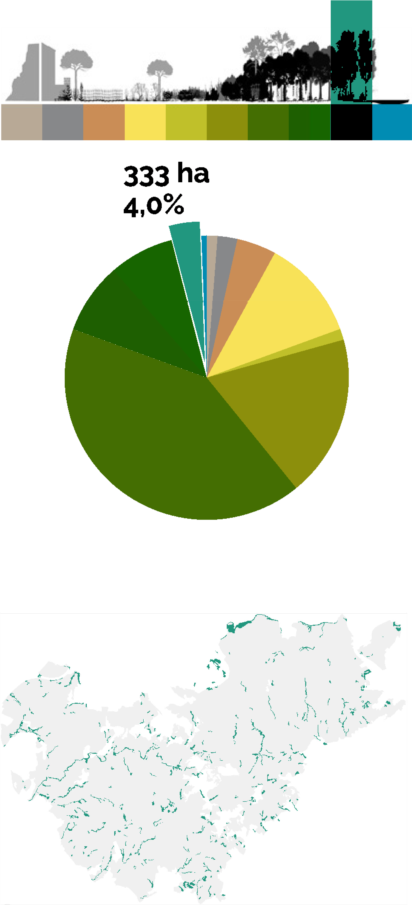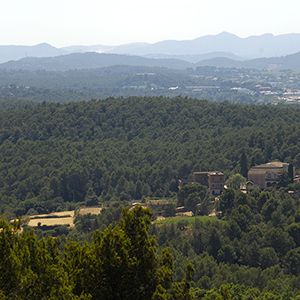There are few riparian woodlands anywhere in the Serra de Collserola. Their distribution is concentrated along the course of torrents and small streams (riera) but also in the sufficiently damp hollows on the northern slopes. The species that make up these woodlands are always highly dependent on edaphic humidity and are generally deciduous.
Examples of riparian woodlands on Collserola are only well represented along the Riera de Sant Medir and the torrents in the same catchment area, the Riera de Vallvidrera and the Rierada stream, the Sant Iscle torrent and the Riera de Sant Cugat.
Different types of plant formations can be found in these areas, at varying distances from the water: willow, ash, poplar and hazel.
In general, the tree stratum is well represented, with such species as the redoul (Coriaria myrtifolia), elder (Sambucus nigra) and common dogwood (Cornus sanguinea). Notable in the herbaceous stratum is the great horsetail (Equisetum telmateia), Italian arum (Arum italicum), rushes (Juncus sp.), cress (Rorippa sp.), leopard’s-bane (Doronicum pardalianches) and sedges (Carex sp.). The verges of tracks that follow watercourses are home to the highly toxic nitrophilous plant known as the Danewort or dwarf elderberry (Sambucus ebulus). This shrub is often confused with the elderberry due to the similarity of their inflorescences, but can be easily differentiated as the Danewort is a perennial with annually herbaceous growth and no characteristic scent.
Riparian environments are particularly vulnerable to anthropization and the establishment of invasive species. Collserola is no exception and we unfortunately find many spots that have become degraded with non-native species, such as the black locust (Robinia pseudoacacia), ailanthus or Tree of Heaven (Ailanthus altissima), London plane (Platanus hispanica) and sycamore (Acer pseudoplatanus).
Grey willow grove
A willow grove (Carici-Salicetum catalaunicae) is a narrow band of vegetation situated right on the water’s edge. Under the grey willows (Salix atrocinerea ssp. catalaunicae) lies the exuberant herbaceous stratum, prominent in which are the giant horsetail (Equisetum telmateia) and sedges (Carex sp.). Exceptionally, in other points of the Rierada we can still find the occasional alder (Alnus glutinosa).
Willow, ash and poplar groves
Various plant formations may be found rooting further from the water’s edge than the grey willow, but still following its course. These consist of different willow species (Salix sp), ash (Fraxinus angustifolia and F. excelsior), silver poplar (Populus alba) and black poplar (Populus nigra) and a few field elm (Ulmus minor) that sprout energetically in those points less affected by the plague of Dutch elm disease. There is also no shortage of bay trees (Laurus nobilis) and common elders (Sambucus nigra), with some wild cherry (Prunus avium) and a few rowan trees (Sorbus sp).
Hazel grove
At some points of the torrents and hollows, on the more shady and humid slopes, appear hazel groves with large ferns (Polysticho-Coryletum). The common hazel (Corylus avellana), almost always small trees or bushes, is often accompanied by the large, soft shield fern (Polystichum setiferum) and other species uncommon on the Serra, such as the wood sanicle (Sanicula europaea). Together, they create a humid environment typical of central European regions, where deciduous and broadleaf vegetation predominates.







